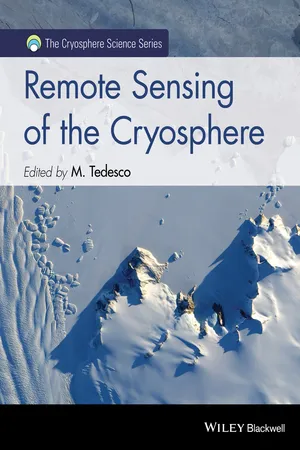
- English
- ePUB (mobile friendly)
- Available on iOS & Android
Remote Sensing of the Cryosphere
About This Book
The cryosphere, that region of the world where water is temporarily or permanently frozen, plays a crucial role on our planet. Recent developments in remote sensing techniques, and the acquisition of new data sets, have resulted in significant advances in our understanding of all components of the cryosphere and its processes.
This book, based on contributions from 40 leading experts, offers a comprehensive and authoritative overview of the methods, techniques and recent advances in applications of remote sensing of the cryosphere. Examples of the topics covered include: • snow extent, depth, grain-size and impurities
• surface and subsurface melting
• glaciers
• accumulation over the Greenland and Antarctica ice sheets
• ice thickness and velocities
• gravimetric measurements from space
• sea, lake and river ice
• frozen ground and permafrost
• fieldwork activities
• recent and future cryosphere-oriented missions and experiments
All figures are in color and provide an excellent visual accompaniment to the technical and scientific aspect of the book.
Readership: Senior undergraduates, Masters and PhD Students, PostDocs and Researchers in cryosphere science and remote sensing. Remote Sensing of the Cryosphere is the significant first volume in the new Cryosphere Science Series. This new series comprises volumes that are at the cutting edge of new research, or provide focussed interdisciplinary reviews of key aspects of the science.
Frequently asked questions
Information
Chapter 1
Remote sensing and the cryosphere
Summary
1.1 Introduction
1.2 Remote sensing
1.2.1 The electromagnetic spectrum and blackbody radiation


Table of contents
- Cover
- Wiley-Blackwell Cryosphere Science Series
- Title Page
- Copyright
- Dedication
- List of contributors
- Cryosphere Science: Series Preface
- Preface
- Acknowledgments
- About the companion website
- Chapter 1: Remote sensing and the cryosphere
- Chapter 2: Electromagnetic properties of components of the cryosphere
- Chapter 3: Remote sensing of snow extent
- Chapter 4: Remote sensing of snow albedo, grain size, and pollution from space
- Chapter 5: Remote sensing of snow depth and snow water equivalent
- Chapter 6: Remote sensing of melting snow and ice
- Chapter 7: Remote sensing of glaciers
- Chapter 8: Remote sensing of accumulation over the Greenland and Antarctic ice sheets
- Chapter 9: Remote sensing of ice thickness and surface velocity
- Chapter 10: Gravimetry measurements from space
- Chapter 11: Remote sensing of sea ice
- Chapter 12: Remote sensing of lake and river ice
- Chapter 13: Remote sensing of permafrost and frozen ground
- Chapter 14: Field measurements for remote sensing of the cryosphere
- Chapter 15: Remote sensing missions and the cryosphere
- Index
- End User License Agreement